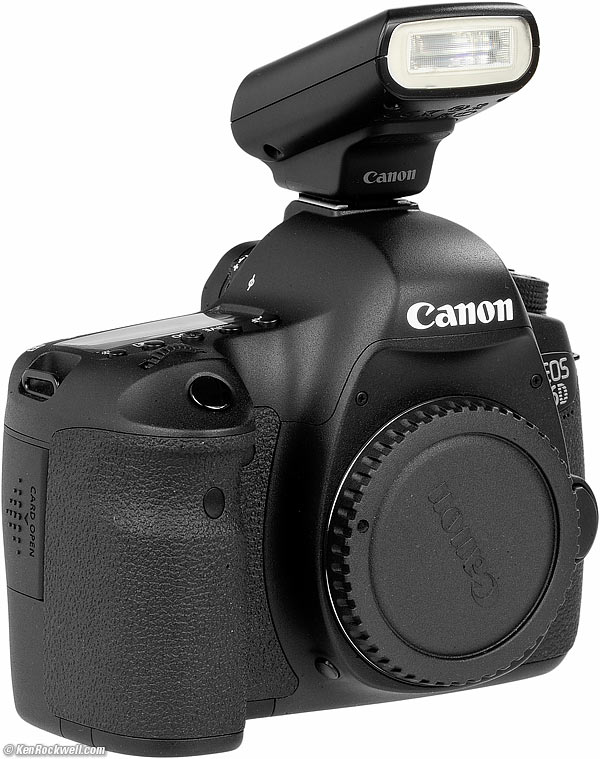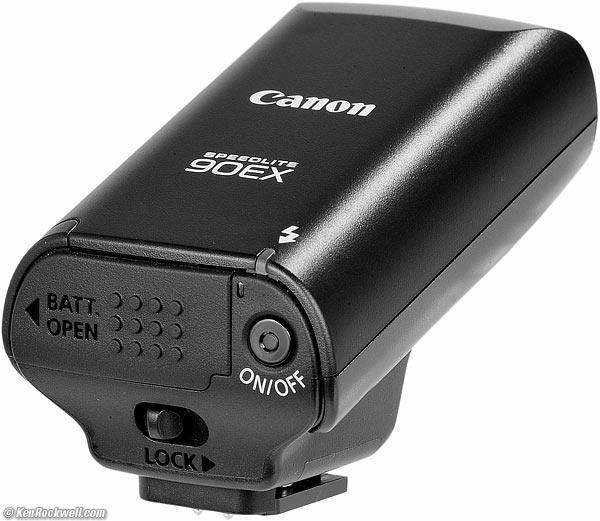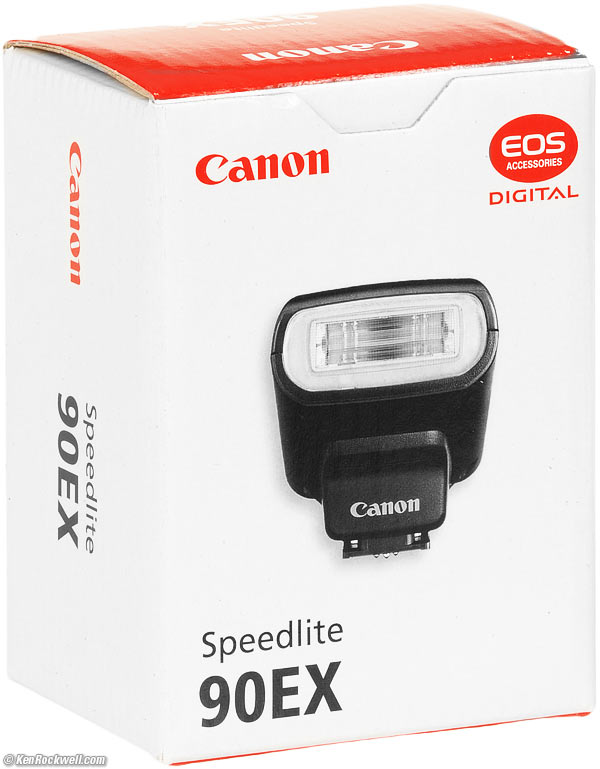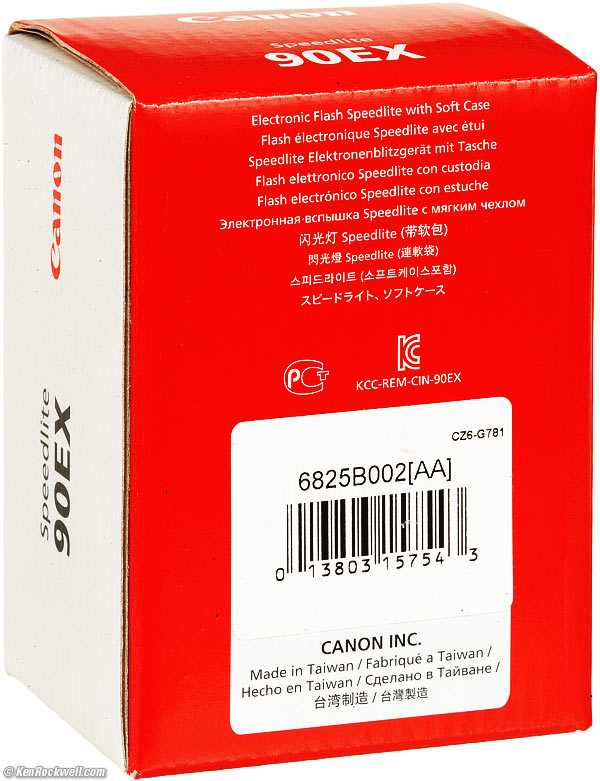Home Donate New Search Gallery Reviews How-To Books Links Workshops About Contact
Canon 90EX Flash
(2012-2017)
© 2013 KenRockwell.com. All rights reserved.
Intro Specs Performance Compared Recommendations More
Canon 90EX flash (2.6 oz./73g with 2 AAA Eneloop cells, GN 9 meters/ 30 feet, about $40 used if you know How to Win at eBay or used at Amazon) atop a Canon 6D. enlarge. My biggest source of support is when you use those or any of these links, when you get anything, regardless of the country in which you live. Thank you! Ken.
Rear, Canon 90EX flash. enlarge.
May 2018 Canon Reviews Canon Flash Canon Lenses All Reviews
Katie reads her Ladybug magazine, 05 January 2013. (Canon 90EX flash for fill flash, Canon 5D Mk III at ISO 100, f/10 at 1/200, Canon 35-80mm f/4-5.6 III at 74mm, Athentech Perfectly Clear plug-in.) bigger.

Unhappy kid, same shot but without 90EX.
Introduction top
Intro Specs Performance Compared Recommendations More
|
|
The Canon 90EX is a wonderfully tiny little flash, however a few small problems make this flash a big failure.
It has very little maximum power, which would be OK except that it also has wimpy charging circuitry which usually takes six full seconds to recharge after nearly every shot. This is because most shots will use all the power this little flash has, so you're almost always going to have to wait six seconds after each shot for it to recycle. If you don't wait six seconds, your shot will take, but without flash.
Its rated guide number of 9 meters is only one-half the power of a built-in pop-up SLR flash with a typical guide number of 13 meters.
Another silly little design flaw is that when it goes to sleep by itself, it never wakes back up. There is no Standby mode, just an auto power off mode. The default Power Save mode turns it off, and doesn't wake it when you wake up your camera. Therefore, you can't just go about your day shooting as you pick up the camera and tapping the shutter to wake. Instead, you have to press and hold the ON switch for at least one full second every time you want to pick up your camera again to reactivate the 90EX. Your only other option is to disable the Power Save mode, in which case it stays on forever and runs down your batteries.
I didn't confirm this, but with only a rated 100 shots per set of AAA cells, you'll be needing to swap them often. You'll get more than 100 shots if you're close enough for the 90EX not to need to shoot at full power, but from my experience, it's almost always having to use all of its limited power for each shot.
AAA cells are not AA or CR123 cells. I don't know about you, but I prefer to avoid equipment that doesn't take the same standard AA cells I carry that fit everything. AAA cell support would require me carrying another set of spares just for this flash.
Specifications top
Intro Specs Performance Compared Recommendations More
Compatibility
As an EOS flash, the 90EX is compatible with all Canon EOS cameras from the very first EOS 650 of 1987 through today's hottest new EOS-M and DSLRs like the T4i, 6D, 5D Mark III and 1D-X.
Yes, I tried it with my 1987 EOS 650, and it really does work just fine, as it does on my 5D Mark III.
Canon rates is as compatible with "Type A" EOS cameras with E TTL II or E TTL.
Lens Coverage
Rated to cover as wide as 24mm on full-frame, but even at 20mm on full-frame it works fine:

Shower, Marseilles. Shot with Canon 20mm f/2.8 USM ultrawide lens on full-frame 5D Mark III.
When you shoot with ultrawide lenses in the real world, things get closer to the camera as they get closer to the edges of the frame, so flashes usually cover much wider lenses than you would think.
In this case, any falloff is subtle, so I'd have no problem shooting this with very wide lenses.
Light Output
Rated Guide Number (GN) 9 meters, 30 feet at ISO 100.
Recycle Time
Rated 5.5 seconds at full power with alkaline cells. (mine takes longer).
Batteries and Power Supply
Two AAA cells.
Rated only 100 flashes per set.
Wireless control
I have no idea how to figure this out, and I think it means that this flash is the slave, not the master.
Quality
Made in Taiwan.
Size
1.7 x 2.0 x 2.6 inches WHD.
44.2 x 52.0 x 65.0 millimeters WHD.
Weight
2.570 oz. (72.9g) with two AAA Eneloop cells (similar with alkaline cells).
1.715 oz. (48.5g) empty.
Canon rates it as 1.8 oz. (50g), empty.
Included
Flash.
Soft case.
Canon Item Code
6825B002
Announced
23 July 2012.
Promised for
October 2012
Shipping Since
November 2012
Price, USA
$40 used, April 2018.
$150, July 2012 - January 2013
Performance top
Intro Specs Performance Compared Recommendations More
Overall
I dislike the 90EX flash because it doesn't shoot fast enough for me.
I prefer my larger 220EX flash that just goes, however as I showed at the top, the 90EX is much better than no flash at all.
Ergonomics
As I covered at the Introduction, a few small flaws make this little flash a big failure.
The power switch is a pushbutton. It has to be held for at least one full second to turn on, long enough to miss a shot. A second is a lifetime while life happens.
Turn-off is immediate, but I much prefer a slide switch over being held hostage holding a button for 1,000 milliseconds just to turn it on.
Any more advanced adjustments have to be done through your camera; the only control on the flash is the power switch (with a green Power On LED) and the ready light (orange LED).
I dislike the idea of having to carry an complete ecosystem for a spare set of AAA cells; I can't use my exhibiting AA cells and chargers or throw-away CR123 lithiums.
Exposure
Exposure is fine.
The camera controls the exposure; the flash has little to do with the equation.
Mechanics and Construction
It's all plastic, with a plastic shoe.
The lock pin is metal.
Light Output
The EX90's light output is enough for basic fill or night use.
Batteries and Power
As covered above, I dislike the short rated battery life, the less-standard AAA cells, the long recycle time and the long time needed to hold the power stitch to turn it on all the time.
By default, the power turns off after 5 minutes of disuse, and has to be turned on again manually to wake up again. Simply waking your camera back up will not wake up this flash, as it does for flashes with a standby mode.
Recycling measures 6 seconds at full power with two AAA Eneloop. Since this little flash needs all of its limited power for most shots, it almost always demands six seconds to recycle for every shot.
AF Illuminator
The 90EX has no infrared AF illuminator.
Any attempts at in-the-dark focus assist will be Canon's disturbing flashing of the actual flash tube, which annoys the beJesus out of living subjects.
Movie Illuminator
There is no continuous light from this little flash; it's not for movies.
Bounce Flash
The 90EX is fixed.
It cannot be tilted, swiveled or bounced.
Compared top
Intro Specs Performance Compared Recommendations More
There is no other Canon flash this tiny.
The 270EX II is the next larger current Canon flash.
My personal favorite is the discontinued 220EX, but it's even larger and faster and more powerful.
See also my Small Flash Comparison.
Recommendations top
Intro Specs Performance Compared Recommendations More
The Canon 90EX is much better than no flash at all. It's easy to pack anywhere or leave on your 5D Mark III or 6D all the time, and by adding fill flash, will improve most of your people pictures far more than any change of camera or lens ever will.
Unfortunately, it takes too darn long to recycle, about as long as built-in flashes and slower than the built-in flash of a Nikon D600, so when you actually try to take more than one shot in a row, only the first shot will be with flash and the second will be without.
With bigger flashes like the 270EX II for the same price, their larger power reserves usually allow a couple of shots at the same time before their capacitor is completely emptied. The 270EX II has nine times the light output of the 90EX.
If you've found all the time, effort and expense I put into researching and sharing all this, this free website's biggest source of support is when you use these links, especially this link directly to it at Adorama or directly to it at Amazon, when you get anything, regardless of the country in which you live.
Thank you!
Ken.
More Information top
Intro Specs Performance Compared Recommendations More
Help me help you top
I support my growing family through this website, as crazy as it might seem.
The biggest help is when you use any of these links when you get anything, regardless of the country in which you live. It costs you nothing, and is this site's, and thus my family's, biggest source of support. These places have the best prices and service, which is why I've used them since before this website existed. I recommend them all personally.
If you find this page as helpful as a book you might have had to buy or a workshop you may have had to take, feel free to help me continue helping everyone.
If you've gotten your gear through one of my links or helped otherwise, you're family. It's great people like you who allow me to keep adding to this site full-time. Thanks!
If you haven't helped yet, please do, and consider helping me with a gift of $5.00.
As this page is copyrighted and formally registered, it is unlawful to make copies, especially in the form of printouts for personal use. If you wish to make a printout for personal use, you are granted one-time permission only if you PayPal me $5.00 per printout or part thereof. Thank you!
Thanks for reading!
Mr. & Mrs. Ken Rockwell, Ryan and Katie.
Home Donate New Search Gallery Reviews How-To Books Links Workshops About Contact









